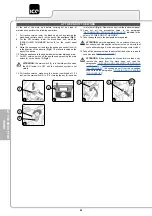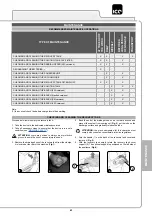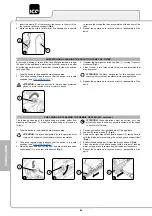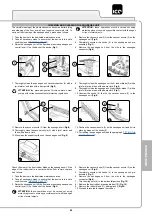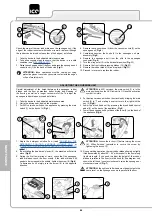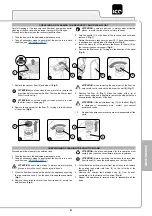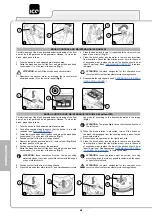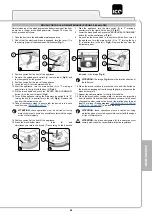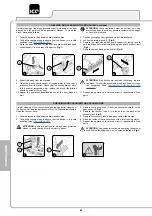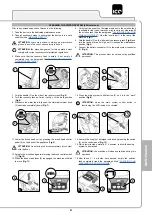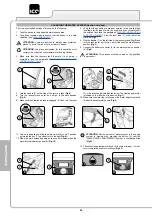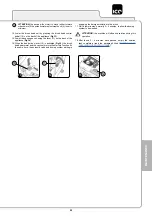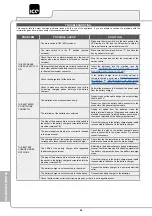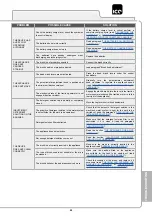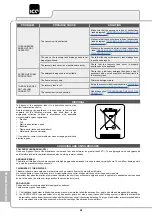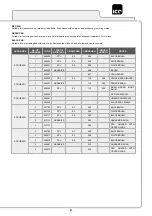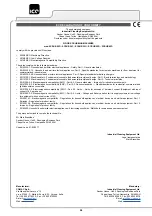
56
TROUBLESHOOTING
DISPOSAL
To dispose of the appliance, take it to a demolition centre or an
authorised collection centre.
Before scrapping the appliance, it is necessary to remove and
separate out the following materials, then send them to the
appropriate collection centres in accordance with applicable
environmental hygiene regulations:
• Brushes
• Felt
• Electric and electronic parts*
• Batteries
• Plastic parts (tanks and handlebars)
• Metal parts (levers and frame)
(*) In particular, contact your distributor when scrapping electric and
electronic parts.
CHOOSING AND USING BRUSHES
POLYPROPYLENE BRUSH (PPL)
Used on all types of floors. Good resistance to wear and tear, and hot water (no greater than 50°C.). The polypropylene is non-hygroscopic
and therefore retains its characteristics even when working in wet conditions.
ABRASIVE BRUSH
The bristles of this type of brush are charged with highly aggressive abrasives. It is used to clean very dirty floors. To avoid floor damage, work
only with the pressure strictly necessary.
THICKNESS OF THE BRISTLES
Thicker bristles are more rigid and are therefore used on smooth floors or floors with small joints.
On uneven floors or those with deep joints, it is advisable to use softer bristles which can enter the gaps more easily.
Remember that when the bristles are worn and therefore too short, they will become rigid and are no longer able to penetrate and clean deep
down. In this case, like with over-large bristles, the brush tends to jump.
PAD HOLDER
The pad holder is recommended for cleaning shiny surfaces.
There are two types of pad holder:
1.
The traditional pad holder is fitted with a series of anchor points that allow the abrasive floor pad to be held and dragged while working.
2. the CENTRE LOCK type pad holder not only has anchor points, but also a snap-type central locking system in plastic that allows the
abrasive floor pad to be perfectly centred and held without any risk of it becoming detached. This type of pad holder is recommended above
all for machines with more than one brush, where the centring of the abrasive discs is difficult.
PROBLEM
POSSIBLE CAUSE
SOLUTION
THE SQUEEGEE
DOES NOT DRY
PERFECTLY
The vacuum unit is obstructed.
Make sure that the squeegee is free of obstructions
(read paragraph “
Make sure that the vacuum hose is free of obstructions
(read paragraph “
Make sure the vacuum cap filter is free of obstructions
(read “
CHECKING AND CLEANING THE RECOVERY
”).
The cap on the recovery tank drainage hose is not
properly positioned.
Check that the cap on the recovery tank drainage hose
is positioned properly.
The recovery tank cover is not positioned correctly.
Check that the recovery tank cover is properly
positioned on the appliance.
EXCESSIVE FOAM
PRODUCTION
The detergent being used is not suitable.
Check that a low foam detergent has been used. If
necessary, add a small quantity of antifoam liquid to
the recovery tank.
The floor is not very dirty.
Dilute the detergent more.
THE DEVICE DOES
NOT VACUUM
CORRECTLY
The recovery tank is full.
Empty the recovery tank (read the section “
AND CLEANING THE RECOVERY TANK
”).
The vacuum device is obstructed
".

